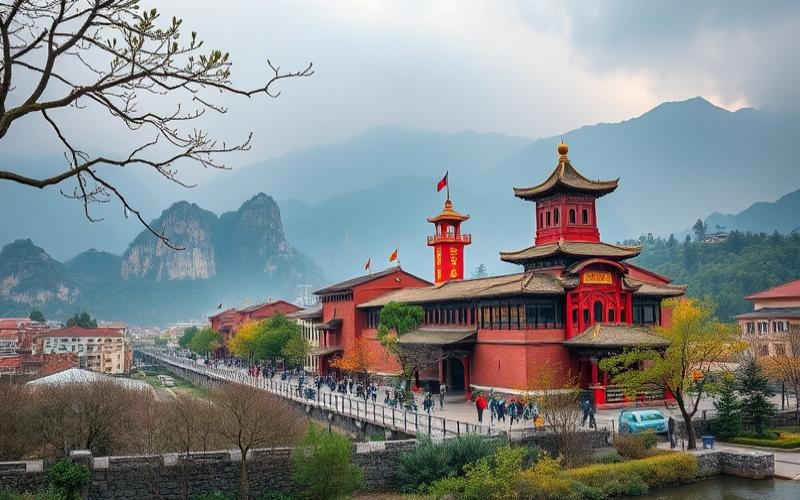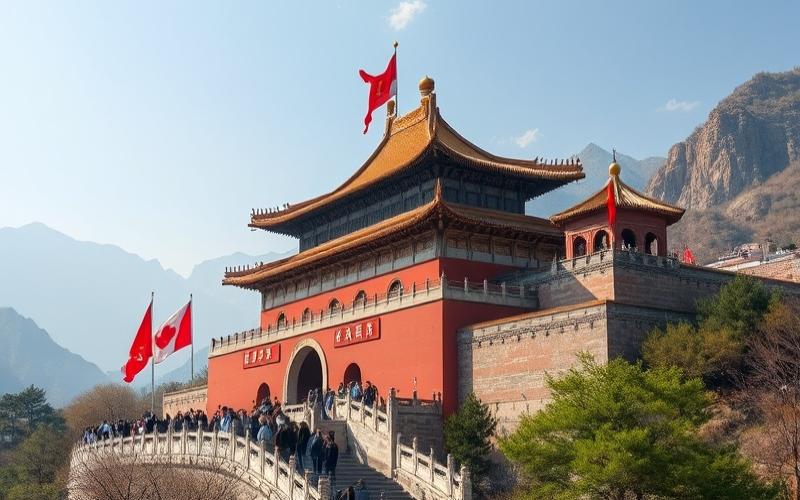
 Published on and written by Cyril Jarnias
Published on and written by Cyril Jarnias
Explore Rural Life in China
An often overlooked domain where ancient traditions and contemporary challenges intertwine. In a country undergoing profound economic and social transformation, China’s countryside maintains a crucial role and offers unique insight into the opportunities and difficulties it faces.
From sustainable agriculture to rural exodus, each aspect raises vital questions about the local economy and cultural preservation. Through this article, let’s delve into the multiple facets of this complex reality to understand how modernity and age-old customs coexist and enrich each other, thereby forging an uncertain yet promising future.
Promoting Rural Areas for Sustainable Development
China has implemented several government initiatives and policies to stimulate rural development, combining support for sustainable agriculture, infrastructure improvement, and enhanced access to education and healthcare.
Support for Sustainable Agriculture
- Adoption of the “No. 1 Central Document” which sets annual priorities for agricultural progress, focusing on preventing rural poverty, strengthening agricultural efficiency, and modernization.
- Deployment of a ten-year master plan focused on food self-sufficiency, with a target annual grain production of 700 million tons by 2027.
- Promotion of inclusive agricultural industrialization that integrates small producers into the economic process while protecting the environment.
Infrastructure Improvement
- Investments in comprehensive rural infrastructure development: roads, power grids, access to high-speed internet.
- Specific programs aimed at improving sanitary and educational conditions in remote villages.
Access to Education and Healthcare
Ambitious goals to reduce gaps between urban and rural areas concerning child development.
Opportunities Offered by Rural Life in China for Expatriates
Rural life in China offers expatriates multiple opportunities, particularly attractive for those seeking space, authenticity, and new entrepreneurial challenges.
Affordable and Spacious Housing
- In rural areas or small Chinese towns, it’s common to find apartments or houses much larger than in urban centers for a very modest price ($150 to $300 per month).
- These homes not only provide increased comfort but also the possibility of setting up professional or creative spaces at home.
Agricultural and Artisanal Activities
- The rural environment facilitates access to land: some expatriates have ventured into permaculture, livestock farming, or local market gardening.
- Others have developed artisanal workshops (ceramics, textiles) leveraging local expertise and abundant raw materials.
Entrepreneurial Development in a Less Saturated Market
- Chinese rural markets are often underutilized by foreigners. This opens the way for innovative projects (eco-lodges, fusion restaurants, cultural workshops).
- Less direct competition allows for better visibility among curious locals open to new experiences.
| Opportunity | Concrete Examples | Main Advantages |
|---|---|---|
| Housing | Renovated traditional house; refurbished farm | Large space; low cost |
| Agriculture/Crafts | Organic farm managed by expat; ceramics workshop with local artisans | Access to land/raw materials; community integration |
| Entrepreneurial Project | Bilingual book café opened in a small town; local e-commerce platform adapted to rural needs | Untapped market; support from local institutions |
Rewarding Cultural Immersion
- Living within a rural community promotes daily Mandarin learning: constant interactions with neighbors and shopkeepers.
- Participation in traditional festivals (rural New Year), local ceremonies, or markets allows for a deep understanding of customs.
Easy Access to Natural Resources & Healthy Environment
- Immediate proximity to mountains, rivers, or forests; year-round accessible sports activities like hiking, cycling, or fishing.
- Fresh local products promote a healthy and sustainable lifestyle; local consumption reducing ecological footprint.
Inspiring Example:
A French-Australian couple settled near Guilin transformed an old farmhouse into an eco-lodge. They offer traditional Chinese cooking classes and guided excursions. Their integration was achieved through involvement in village associations and daily sharing with their farmer neighbors.
Main Benefits Reported by Expatriates Who Made This Choice
- Significant improvement in language level thanks to total immersion
- Rapid development of a strong local network
- Increased sense of personal security
- Rediscovery of natural rhythm away from urban stress
Key Points for Successful Integration
- Demonstrate constant cultural openness
- Actively participate in community life: agricultural mutual aid, festival organization
- Value informal exchanges to accelerate language learning
Thus, rural life in China proves to be a true personal laboratory where quality of life rhymes with unique opportunities.
Good to Know:
Rural life in China offers expatriates numerous opportunities, notably through spacious and affordable housing. Additionally, it’s possible to engage in agricultural or artisanal activities, or launch entrepreneurial projects in a less competitive market. Immersing in a rural community culturally enriches expatriates, promoting language learning and local customs. Furthermore, proximity to natural resources and a peaceful setting encourages a healthier and more sustainable lifestyle. Successful examples include expatriate chefs who opened organic restaurants or artisans incorporating traditional techniques into their products. These experiences testify to the tangible benefits of rural life in China for expatriates seeking opportunities and an enriching life experience.
Challenges Faced in the Chinese Countryside and Possible Solutions
Current Challenges in Chinese Rural Areas:
- Massive Rural Exodus: Many young people leave villages for cities, causing a labor shortage, accelerated aging of the rural population, and marked demographic imbalance.
- Aging Population: The rural population consists of a growing number of elderly, often less educated and more vulnerable to health and economic risks.
- Limited Access to Modern Technologies: Adoption of digital technologies, agricultural mechanization, and smart solutions remains uneven, hindering innovation and productivity.
- Poor Access to Education: Rural educational infrastructure is often underdeveloped, leading to lower education levels than in urban areas.
- Environmental Problems Linked to Intensive Agriculture: Excessive use of fertilizers and pesticides, soil degradation, water pollution, and biodiversity loss are exacerbated by traditional farming practices.
Summary Table of Challenges and Their Impacts
| Main Challenge | Major Impact |
|---|---|
| Rural Exodus | Labor shortage, demographic decline |
| Aging Population | Decreased productivity, vulnerability |
| Limited Technology Access | Modernization delay, low innovation |
| Limited Education Access | Low qualification, social stagnation |
| Intensive Agriculture and Pollution | Environmental degradation, health risks |
Possible Solutions and Concrete Initiatives
- Infrastructure Development
Construction and renovation of roads, drinking water networks, housing, and school infrastructure.
Example: National program to build 1,000 model villages with public funding. - Promotion of Sustainable Agriculture
Encouragement of ecological farming, reduction of chemical inputs, improvement of water and soil management.
Adoption of environmentally friendly techniques: crop rotation, use of organic fertilizers. - Integration of New Technologies
Deployment of agricultural mechanization, smart irrigation, and digital tools for farm management.
Examples: Online agricultural trading platforms, drones for crop monitoring. - Training and Education Programs
Creation of training centers for farmers to disseminate good agricultural practices and technology use.
Partnerships with universities and technical institutes for youth education in rural areas. - Rural Revitalization through Targeted Policies
Implementation of the National Rural Revitalization Strategy, aiming to reduce the urban-rural gap, promote inclusive agricultural industrialization, and improve social protection.
Direct support to small producers for their integration into value chains and market access.
Concrete Examples of Government or Local Initiatives:
- Rural Revitalization Strategy: National policy focused on agricultural modernization, infrastructure development, and environmental protection.
- Pilot Projects for Ecological Villages: Construction of villages integrating renewable energy, sustainable water management, and smart agricultural systems.
- Public Funding for Rural Innovation: Subsidies for farm modernization and adoption of sustainable agricultural practices.
- High-Speed Internet Deployment: Improvement of digital connectivity in rural areas to facilitate access to information, education, and markets.
Summary
Chinese rural areas face major challenges such as rural exodus, aging population, limited access to technology and education, and environmental pressures. To address these, China is betting on rural revitalization, infrastructure development, sustainable agriculture, technological integration, and training programs, supported by ambitious public policies and innovative local initiatives.
Good to Know:
In the Chinese countryside, rural exodus and population aging pose serious challenges, aggravated by limited access to modern technologies and education, and environmental problems due to intensive agriculture. Facing these challenges, China is focusing on infrastructure development, such as improving road networks and internet to reduce rural isolation, and promoting sustainable agriculture through subsidies for ecological practices. Initiatives like the “Rural Vitalization” program have been established to integrate new technologies into agriculture, thereby increasing efficiency and attracting youth. Concrete examples include encouraging high-tech agricultural startups and supporting vocational training programs to make these regions autonomous and dynamic.
Disclaimer: The information provided on this website is for informational purposes only and does not constitute financial, legal, or professional advice. We encourage you to consult qualified experts before making any investment, real estate, or expatriation decisions. Although we strive to maintain up-to-date and accurate information, we do not guarantee the completeness, accuracy, or timeliness of the proposed content. As investment and expatriation involve risks, we disclaim any liability for potential losses or damages arising from the use of this site. Your use of this site confirms your acceptance of these terms and your understanding of the associated risks.




















































